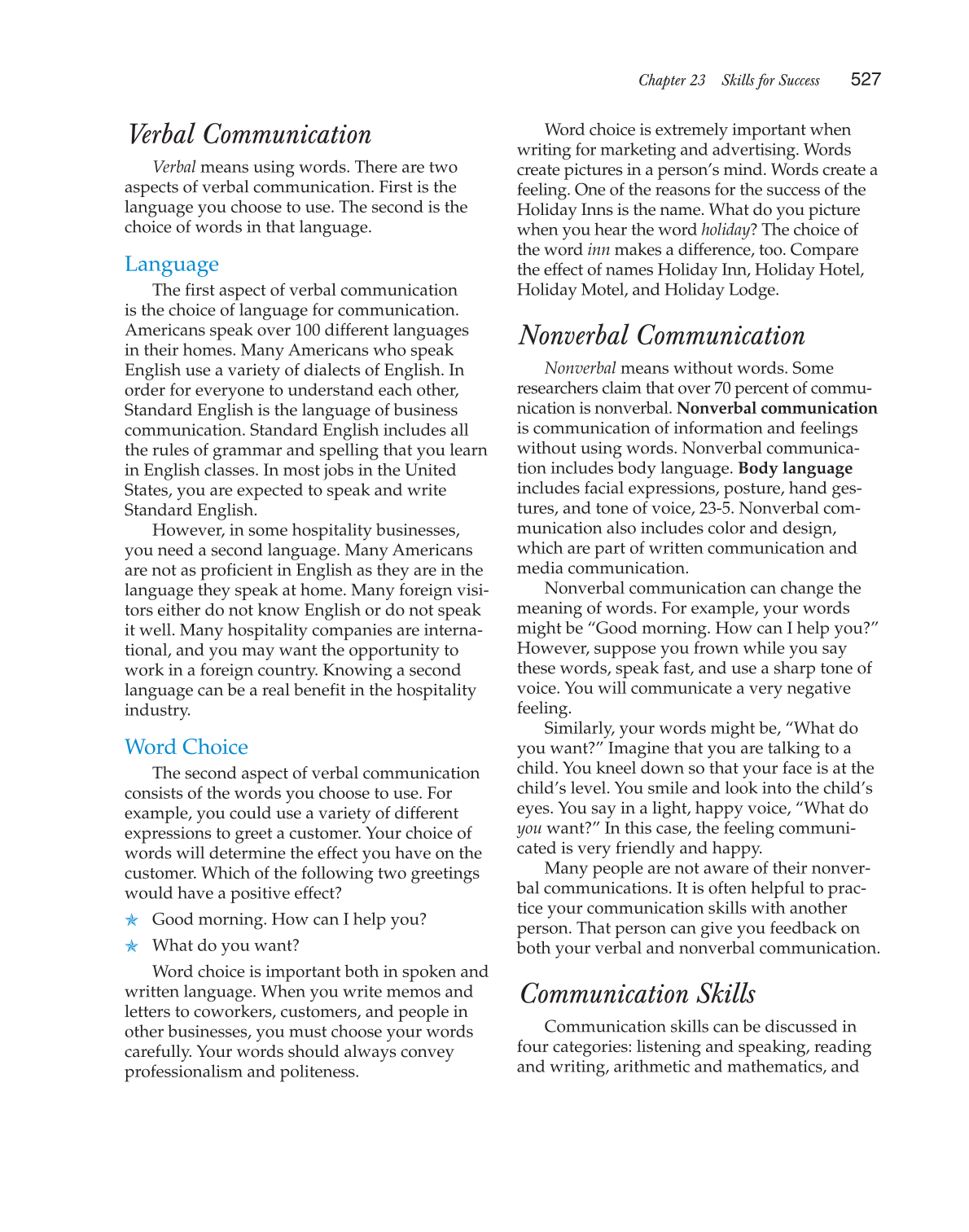Verbal Communication
Verbal means using words. There are two
aspects of verbal communication. First is the
language you choose to use. The second is the
choice of words in that language.
Language
The first aspect of verbal communication
is the choice of language for communication.
Americans speak over 100 different languages
in their homes. Many Americans who speak
English use a variety of dialects of English. In
order for everyone to understand each other,
Standard English is the language of business
communication. Standard English includes all
the rules of grammar and spelling that you learn
in English classes. In most jobs in the United
States, you are expected to speak and write
Standard English.
However, in some hospitality businesses,
you need a second language. Many Americans
are not as proficient in English as they are in the
language they speak at home. Many foreign visi-
tors either do not know English or do not speak
it well. Many hospitality companies are interna-
tional, and you may want the opportunity to
work in a foreign country. Knowing a second
language can be a real benefit in the hospitality
industry.
Word Choice
The second aspect of verbal communication
consists of the words you choose to use. For
example, you could use a variety of different
expressions to greet a customer. Your choice of
words will determine the effect you have on the
customer. Which of the following two greetings
would have a positive effect?
Good morning. How can I help you?
What do you want?
Word choice is important both in spoken and
written language. When you write memos and
letters to coworkers, customers, and people in
other businesses, you must choose your words
carefully. Your words should always convey
professionalism and politeness.
Word choice is extremely important when
writing for marketing and advertising. Words
create pictures in a person’s mind. Words create a
feeling. One of the reasons for the success of the
Holiday Inns is the name. What do you picture
when you hear the word holiday? The choice of
the word inn makes a difference, too. Compare
the effect of names Holiday Inn, Holiday Hotel,
Holiday Motel, and Holiday Lodge.
Nonverbal Communication
Nonverbal means without words. Some
researchers claim that over 70 percent of commu-
nication is nonverbal. Nonverbal communication
is communication of information and feelings
without using words. Nonverbal communica-
tion includes body language. Body language
includes facial expressions, posture, hand ges-
tures, and tone of voice, 23-5. Nonverbal com-
munication also includes color and design,
which are part of written communication and
media communication.
Nonverbal communication can change the
meaning of words. For example, your words
might be “Good morning. How can I help you?”
However, suppose you frown while you say
these words, speak fast, and use a sharp tone of
voice. You will communicate a very negative
feeling.
Similarly, your words might be, “What do
you want?” Imagine that you are talking to a
child. You kneel down so that your face is at the
child’s level. You smile and look into the child’s
eyes. You say in a light, happy voice, “What do
you want?” In this case, the feeling communi-
cated is very friendly and happy.
Many people are not aware of their nonver-
bal communications. It is often helpful to prac-
tice your communication skills with another
person. That person can give you feedback on
both your verbal and nonverbal communication.
Communication Skills
Communication skills can be discussed in
four categories: listening and speaking, reading
and writing, arithmetic and mathematics, and
Chapter 23 Skills for Success
527
